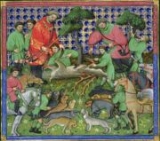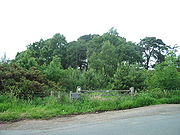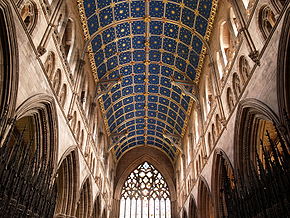
The Awntyrs off Arthure
Encyclopedia
The Awntyrs off Arthure at the Terne Wathelyne (The Adventures of Arthur at Tarn Wadling) is an Arthurian
romance of 702 lines written in Middle English
alliterative verse
. Despite its title, it centres on the deeds of Sir Gawain
. The poem, thought to have been composed in Cumberland
in the late 14th or early 15th century, was clearly very popular in its time, as it survives in four different manuscripts from widely separated areas of England.
 At the lake Tarn Wadling, Gawain
At the lake Tarn Wadling, Gawain
and Guinevere
("Gaynour") encounter a hideous and vividly-described ghost, who reveals that she is Guinevere's mother, condemned to suffer for the sins of adultery and pride that she committed while alive. In response to Gawain and Guinevere's questions, she advises them to live morally and to "have pité on the poer [...] Sithen charité is chef" ("have pity on the poor [...] charity is paramount"), and prophecies that the Round Table
will ultimately be destroyed by Mordred
. She ends by requesting that masses
are said for her soul. The episode, featuring characters who, while on a hunt, are plunged into darkness before meeting a ghost, has strong thematic similarities to another stanzaic alliterative poem, The Three Dead Kings, and seems to be derived from a popular legend of Saint Gregory
.
The second half of the poem covers a different story: a knight, Sir Galeron of Galloway, claims that King Arthur
and Gawain have false possession of his lands, and demands to settle the issue through honourable combat ("I wol fight on a felde - thereto I make feith") Gawain, who takes up the challenge, has the upper hand, and seems about to kill Galeron; but Galeron's lady and Guinevere intervene, and Arthur calls a halt to the fight. An amicable settlement is made of the land ownership, Galeron marries his lady, and become a knight of the Round Table
. In the final stanza, Guinevere arranges masses for her mother's soul, and bells are rung throughout Britain (signifying public celebration, and the passage of a soul from Purgatory), bringing the narrative full circle in a "happy ending".
The two parts of the poem were long thought to be a conflation of two entirely separate texts, especially as the chivalric
concerns of the second half seem to directly contradict the message of humility contained in the first. Medievalist Ralph Hanna, who edited the text, felt that the first episode had been adapted by a second, less technically assured author, who added the Galeron section and ended with the original final stanza of the first poem. However, following the work of A. C. Spearing — who compared its structure to that of a diptych
— the Awntyrs is now commonly seen as a unified work by a single poet, where the themes of the first half are reflected in the second.

Variants of the thirteen-line alliterating stanza are found in a handful of other English poems: The Four Leaves of the Truelove, The Three Dead Kings
, The Pistel of Swete Susan, and a number of others.
 The identity of the poet is entirely unknown. Though the manuscript copies display very different scribal dialects, there are traces of an underlying dialect of the far north-western borders of England. Given the location of Arthur's court at Carlisle, and of much of the poem's action at Tarn Wadling and in Inglewood Forest
The identity of the poet is entirely unknown. Though the manuscript copies display very different scribal dialects, there are traces of an underlying dialect of the far north-western borders of England. Given the location of Arthur's court at Carlisle, and of much of the poem's action at Tarn Wadling and in Inglewood Forest
— both in Cumberland— the author was most likely an educated native of the area, perhaps a cleric. The Augustinian Canons, whose members were often involved in the production of literature, were based at Carlisle and had fishing rights at Tarn Wadling; it has been speculated that the author could have belonged to this order.
Academic Rosamund Allen has argued that a likely patron for the poem was Joan Beaufort, Countess of Westmorland
, with the text composed as a dramatic entertainment for a marriage, or other important celebration, during the mid-1420s.
.
King Arthur
King Arthur is a legendary British leader of the late 5th and early 6th centuries, who, according to Medieval histories and romances, led the defence of Britain against Saxon invaders in the early 6th century. The details of Arthur's story are mainly composed of folklore and literary invention, and...
romance of 702 lines written in Middle English
Middle English
Middle English is the stage in the history of the English language during the High and Late Middle Ages, or roughly during the four centuries between the late 11th and the late 15th century....
alliterative verse
Alliterative verse
In prosody, alliterative verse is a form of verse that uses alliteration as the principal structuring device to unify lines of poetry, as opposed to other devices such as rhyme. The most commonly studied traditions of alliterative verse are those found in the oldest literature of many Germanic...
. Despite its title, it centres on the deeds of Sir Gawain
Gawain
Gawain is King Arthur's nephew and a Knight of the Round Table who appears very early in the Arthurian legend's development. He is one of a select number of Round Table members to be referred to as the greatest knight, most notably in Sir Gawain and the Green Knight...
. The poem, thought to have been composed in Cumberland
Cumberland
Cumberland is a historic county of North West England, on the border with Scotland, from the 12th century until 1974. It formed an administrative county from 1889 to 1974 and now forms part of Cumbria....
in the late 14th or early 15th century, was clearly very popular in its time, as it survives in four different manuscripts from widely separated areas of England.
Synopsis
Although the Awntyrs off Arthure is in some respects typical of the romances featuring Gawain, it has peculiarities of structure and theme that set it apart. It begins conventionally enough, with Arthur's court riding out to a hunt.
Gawain
Gawain is King Arthur's nephew and a Knight of the Round Table who appears very early in the Arthurian legend's development. He is one of a select number of Round Table members to be referred to as the greatest knight, most notably in Sir Gawain and the Green Knight...
and Guinevere
Guinevere
Guinevere was the legendary queen consort of King Arthur. In tales and folklore, she was said to have had a love affair with Arthur's chief knight Sir Lancelot...
("Gaynour") encounter a hideous and vividly-described ghost, who reveals that she is Guinevere's mother, condemned to suffer for the sins of adultery and pride that she committed while alive. In response to Gawain and Guinevere's questions, she advises them to live morally and to "have pité on the poer [...] Sithen charité is chef" ("have pity on the poor [...] charity is paramount"), and prophecies that the Round Table
Round Table
The Round Table is King Arthur's famed table in the Arthurian legend, around which he and his Knights congregate. As its name suggests, it has no head, implying that everyone who sits there has equal status. The table was first described in 1155 by Wace, who relied on previous depictions of...
will ultimately be destroyed by Mordred
Mordred
Mordred or Modred is a character in the Arthurian legend, known as a notorious traitor who fought King Arthur at the Battle of Camlann, where he was killed and Arthur fatally wounded. Tradition varies on his relationship to Arthur, but he is best known today as Arthur's illegitimate son by his...
. She ends by requesting that masses
Mass (liturgy)
"Mass" is one of the names by which the sacrament of the Eucharist is called in the Roman Catholic Church: others are "Eucharist", the "Lord's Supper", the "Breaking of Bread", the "Eucharistic assembly ", the "memorial of the Lord's Passion and Resurrection", the "Holy Sacrifice", the "Holy and...
are said for her soul. The episode, featuring characters who, while on a hunt, are plunged into darkness before meeting a ghost, has strong thematic similarities to another stanzaic alliterative poem, The Three Dead Kings, and seems to be derived from a popular legend of Saint Gregory
Pope Gregory I
Pope Gregory I , better known in English as Gregory the Great, was pope from 3 September 590 until his death...
.
The second half of the poem covers a different story: a knight, Sir Galeron of Galloway, claims that King Arthur
King Arthur
King Arthur is a legendary British leader of the late 5th and early 6th centuries, who, according to Medieval histories and romances, led the defence of Britain against Saxon invaders in the early 6th century. The details of Arthur's story are mainly composed of folklore and literary invention, and...
and Gawain have false possession of his lands, and demands to settle the issue through honourable combat ("I wol fight on a felde - thereto I make feith") Gawain, who takes up the challenge, has the upper hand, and seems about to kill Galeron; but Galeron's lady and Guinevere intervene, and Arthur calls a halt to the fight. An amicable settlement is made of the land ownership, Galeron marries his lady, and become a knight of the Round Table
Round Table
The Round Table is King Arthur's famed table in the Arthurian legend, around which he and his Knights congregate. As its name suggests, it has no head, implying that everyone who sits there has equal status. The table was first described in 1155 by Wace, who relied on previous depictions of...
. In the final stanza, Guinevere arranges masses for her mother's soul, and bells are rung throughout Britain (signifying public celebration, and the passage of a soul from Purgatory), bringing the narrative full circle in a "happy ending".
The two parts of the poem were long thought to be a conflation of two entirely separate texts, especially as the chivalric
Chivalry
Chivalry is a term related to the medieval institution of knighthood which has an aristocratic military origin of individual training and service to others. Chivalry was also the term used to refer to a group of mounted men-at-arms as well as to martial valour...
concerns of the second half seem to directly contradict the message of humility contained in the first. Medievalist Ralph Hanna, who edited the text, felt that the first episode had been adapted by a second, less technically assured author, who added the Galeron section and ended with the original final stanza of the first poem. However, following the work of A. C. Spearing — who compared its structure to that of a diptych
Diptych
A diptych di "two" + ptychē "fold") is any object with two flat plates attached at a hinge. Devices of this form were quite popular in the ancient world, wax tablets being coated with wax on inner faces, for recording notes and for measuring time and direction.In Late Antiquity, ivory diptychs with...
— the Awntyrs is now commonly seen as a unified work by a single poet, where the themes of the first half are reflected in the second.
Verse form
The Awntyrs off Arthure is written in a form of alliterative verse combining the usual four-stress alliterative line with a rhyme ababababcdddc in a thirteen-line stanza; the density of alliteration is higher than in any other Middle English poem, with over half of its lines containing four alliterating stresses rather than the customary three. The style can be illustrated by the opening stanza:
- In the tyme of Arthur an aunter bytydde,
- By the Turne Wathelan, as the boke telles,
- Whan he to Carlele was comen, that conquerour kydde,
- With dukes and dussiperes that with the dere dwelles.
- To hunte at the herdes that longe had ben hydde,
- On a day thei hem dight to the depe delles,
- To fall of the femailes in forest were frydde,
- Fayre by the fermesones in frithes and felles.
- Thus to wode arn thei went, the wlonkest in wedes,
- Bothe the Kyng and the Quene,
- And al the doughti bydene.
- Sir Gawayn, gayest on grene,
- Dame Gaynour he ledes. (1–13)
Variants of the thirteen-line alliterating stanza are found in a handful of other English poems: The Four Leaves of the Truelove, The Three Dead Kings
The Three Dead Kings
The Three Dead Kings, also known by its Latin title De Tribus Regibus Mortuis or as The Three Living and the Three Dead, is a 15th-century Middle English poem. It is found in the manuscript MS. Douce 302, and its authorship is sometimes attributed to a Shropshire priest, John Audelay...
, The Pistel of Swete Susan, and a number of others.
Composition

Inglewood Forest
Inglewood Forest is the name now given on maps to a large tract of mainly arable and dairy farm land with a few small woodland areas between Carlisle and Penrith in the English non-metropolitan county of Cumbria or ancient county of Cumberland....
— both in Cumberland— the author was most likely an educated native of the area, perhaps a cleric. The Augustinian Canons, whose members were often involved in the production of literature, were based at Carlisle and had fishing rights at Tarn Wadling; it has been speculated that the author could have belonged to this order.
Academic Rosamund Allen has argued that a likely patron for the poem was Joan Beaufort, Countess of Westmorland
Joan Beaufort, Countess of Westmorland
Joan Beaufort, Countess of Westmorland was the third or fourth child of John of Gaunt, 1st Duke of Lancaster and his mistress, later wife, Katherine Swynford; and, in her widowhood, a powerful landowner in the North of England.-Early life and marriages:She was likely born at the Swynford manor of...
, with the text composed as a dramatic entertainment for a marriage, or other important celebration, during the mid-1420s.
Manuscripts
The poem is preserved in four different manuscripts, one of which is the mid-fifteenth century Lincoln Thornton ManuscriptLincoln Thornton Manuscript
The Lincoln Thornton Manuscript is a medieval manuscript compiled and copied by the fifteenth-century English scribe and landowner Robert Thornton. The manuscript is notable for containing single versions of important poems such as the Alliterative Morte Arthure and Sir Perceval of Galles, and...
.

